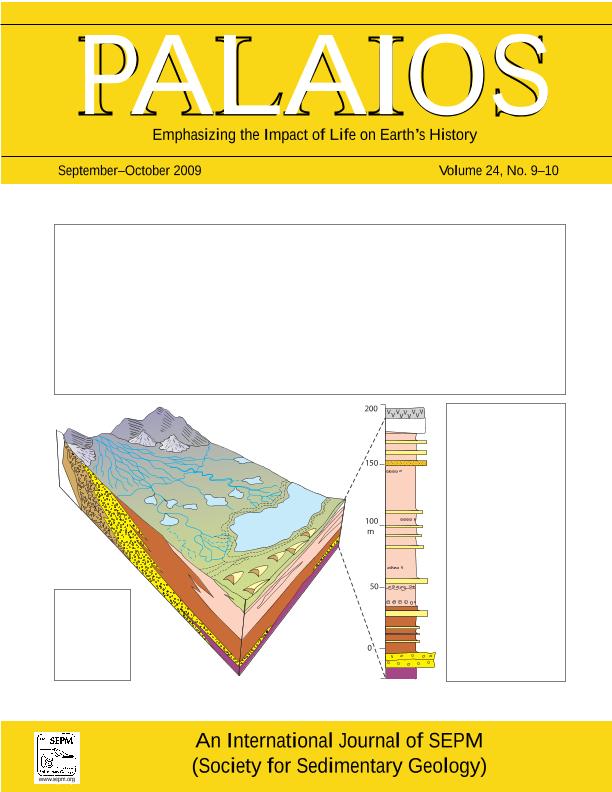Mostrar el registro sencillo del ítem
dc.contributor.author
Smith, Roger M. H.

dc.contributor.author
Marsicano, Claudia Alicia

dc.contributor.author
Wilson, Jeffrey A.
dc.date.available
2019-12-20T22:01:43Z
dc.date.issued
2009-10
dc.identifier.citation
Smith, Roger M. H.; Marsicano, Claudia Alicia; Wilson, Jeffrey A.; Sedimentology and paleoecology of a diverse Early Jurassic tetrapod tracksite in Lesotho, southern Africa; Society for Sedimentary Geology; Palaios; 24; 10; 10-2009; 672-684
dc.identifier.issn
0883-1351
dc.identifier.uri
http://hdl.handle.net/11336/92706
dc.description.abstract
An Early Jurassic tetrapod tracksite in the upper Elliot Formation at Moyeni, southern Lesotho, displays a variety of trackways attributed to large- and medium-sized theropod (Neotrisauropus-type) and ornithischian (Moyenisauropus-type) dinosaurs, basal crurotarsal archosaurs (chirotheroid-type), and a short-legged basal tetrapod (Episcopopus-type). The tracks are on a low-angle pointbar and are buried with loessic floodplain fine-grained sediment. Calcic paleosols indicate a warm semiarid climate. Many of the footprints were imprinted through an algal mat in a water-margin setting. Convergence of several trackways toward a single point suggests repeated visits to drink or cross the river. One of the two large Moyenisauropus-type trackways has a narrow gauge that suggests an upright, parasagittal gait, whereas the other shows changes in gauge width, stance, and posture as it proceeded up the pointbar slope. At least three resting traces with manus, metatarsal, and tail impressions attributable to the Moyenisauropus-type ornithischian are also preserved. Discovery of two manus-pes pairs of chirotheroid-type footprints in the Moyeni section highlights a mismatch between the body-fossil and trace-fossil records. Chirotheroid tracks are generally thought to be restricted to the Triassic, and their discovery at the Moyeni tracksite compounds the problem of where to place the Triassic-Jurassic boundary in this succession. Three possible scenarios could explain the occurrence of chirotheroid-type tracks at Moyeni: (1) the tracksite is Late Triassic in age; (2) the chirotheroid tracks were made by archosaurs other than basal crurotarsans; (3) the tracks are correctly identified and the age of the Moyeni section is correctly assigned, but the inferred range of chirotheroid-type tracks is incorrect. We suggest that the latter two are the most likely explanations.
dc.format
application/pdf
dc.language.iso
eng
dc.publisher
Society for Sedimentary Geology

dc.rights
info:eu-repo/semantics/openAccess
dc.rights.uri
https://creativecommons.org/licenses/by-nc-sa/2.5/ar/
dc.subject
Sedimentology
dc.subject
Tetrapod footprints
dc.subject
Palaeoecology
dc.subject
Lower Jurassic Lesotho
dc.subject.classification
Otras Ciencias de la Tierra y relacionadas con el Medio Ambiente

dc.subject.classification
Ciencias de la Tierra y relacionadas con el Medio Ambiente

dc.subject.classification
CIENCIAS NATURALES Y EXACTAS

dc.title
Sedimentology and paleoecology of a diverse Early Jurassic tetrapod tracksite in Lesotho, southern Africa
dc.type
info:eu-repo/semantics/article
dc.type
info:ar-repo/semantics/artículo
dc.type
info:eu-repo/semantics/publishedVersion
dc.date.updated
2019-10-01T14:51:59Z
dc.journal.volume
24
dc.journal.number
10
dc.journal.pagination
672-684
dc.journal.pais
Estados Unidos

dc.journal.ciudad
Lawrence
dc.description.fil
Fil: Smith, Roger M.H.. Department of Karoo Palaeontology, Iziko South African Museum; Sudáfrica
dc.description.fil
Fil: Marsicano, Claudia Alicia. Consejo Nacional de Investigaciones Científicas y Técnicas. Oficina de Coordinación Administrativa Ciudad Universitaria. Instituto de Estudios Andinos "Don Pablo Groeber". Universidad de Buenos Aires. Facultad de Ciencias Exactas y Naturales. Instituto de Estudios Andinos "Don Pablo Groeber"; Argentina
dc.description.fil
Fil: Wilson, Jeffrey A.. University of Michigan; Estados Unidos
dc.journal.title
Palaios

dc.relation.alternativeid
info:eu-repo/semantics/altIdentifier/doi/http://dx.doi.org/10.2110/palo.2008.p08-115r
dc.relation.alternativeid
info:eu-repo/semantics/altIdentifier/url/https://pubs.geoscienceworld.org/palaios/article/24/10/672-684/146023
Archivos asociados
